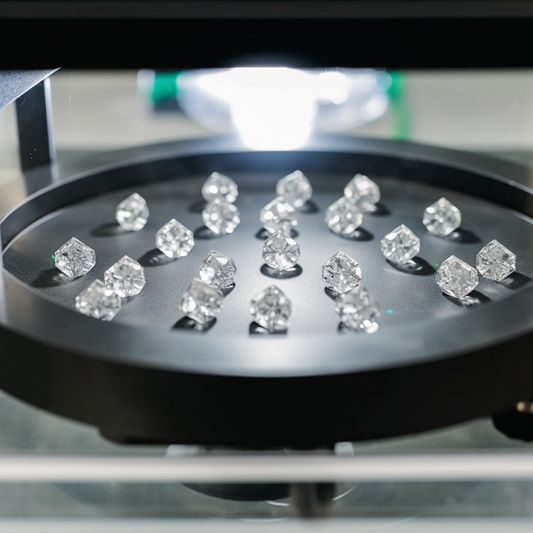Whenever we look at a diamond, we admire its beauty and brilliance. But seldom do we ask ourselves how it came into existence. But we should because the history of any gem is far more colorful and fascinating than the stone itself. Moreover, the intense geological processes and billions of years required for these minerals to form will make you appreciate their rarity even more. Answering these questions and more will help you understand what mineral evolution is all about.
What is Mineral Evolution?
Mineral evolution is a multi-disciplinary subset of mineralogy that gives it historical context. In essence, it answers some critical questions, such as “where did minerals come from?” and “what causes minerals to form in different ways?”
The discipline was born out of a simple question by American biophysicist Harold Morowitz: “Were there clay minerals in the Archean?” The lack of a concrete answer led a group of mineralogists and geologists to an intense year-long study. The conclusion is a research paper entitled Mineral Evolution (Hazen et al.) that laid the groundwork for the new field.
The core concept of mineral evolution is that the minerals we see today were formed due to a combination of physical, chemical, and biological processes deep inside planets, moons, and stars.
When the universe began, no minerals existed yet because everything was just composed of gases. But as stars formed, so did the heavier elements like iron and carbon. The intense heat and pressure of star cores also helped develop minerals like diamond and silicates.
These minerals and other particles eventually clumped together to form planets and moons, including our own Earth. From there, a series of geological processes took place that transformed these early minerals into today’s crystals and gemstones.
Mineral Evolution: Foundation Facts
Let’s go over some common questions regarding the foundations of how minerals came to be.
How are minerals formed in the Earth?
Mineral evolution in the Earth was driven by three main mechanisms occurring over millions of years.
First is the separation and concentration of elements that allowed them to form mineral groups. Geologists describe 4 processes that result in the formation of minerals. These include planetary differentiation, melting, fractional crystallization, and outgassing. These processes helped form early land masses made of granite.
Next is the movement of the landmasses in the Earth’s crust, called plate tectonics. So, what effect does plate tectonics have on organic evolution and that of minerals? The constant movement of the plates exposed minerals to varying pressures, temperatures, and other mineral formations. This allowed chemical and physical processes to occur that formed modern minerals and other variables necessary for organic life.
And thanks to organic life, the final mechanism took place. Called the Great Oxygenation Event, this was caused by mass photosynthesis that released high concentrations of oxygen into the atmosphere. The minerals oxidized as a result and formed completely new mineral compounds, such as oxides.
How long does it take for a mineral to form?
The mechanisms and intense processes that shape minerals are only possible through millions of years. A diamond, for example, needs around 1 – 3.3 billion years of extreme heat and pressure to develop.
How Do We Get Minerals from the Earth?
Generally speaking, extracting minerals and gemstones from the Earth is a demanding and expensive process. It’s the reason why diamonds and other gems feature such a high price tag.
There are three primary extraction processes available, depending on the underlying geology of the mineral deposit.
- Open-pit mining or quarries will suffice for lower grade, less expensive minerals that form relatively close to the Earth’s surface. The method involves digging relatively shallow pits through drilling or blasting to expose ore veins. Because they don’t require much effort, pit mines are a relatively inexpensive operation.
- Extracting more valuable minerals deeper into the Earth, however, requires drilling for an underground mine. This is a much more extensive and dangerous operation, contributing to the higher cost of the resulting minerals.
- The last method, placer mining, is used to sift minerals in beach sand and river beds. This was how gold was mined in the US and how present-day titanium is extracted.
The main issue with these mining operations is that they’re a very intrusive process. Mining often requires explosives and cutting down trees, which cause significant harm to the environment. Worse, mining is dangerous for the workers involved. Diamonds, in particular, are notorious for being mined in war-torn areas and used to finance further conflict.
Mineral Alternatives
Fortunately, there are more sustainable alternatives over minerals that might have been sourced with less than ideal methods. One of these is synthetic gemstones.
Despite what jewelers chasing a high commission will tell you, lab-grown gemstones are worthy alternatives — despite the stigma that they’re not as valuable. Lab-created moissanite, for instance, has the same visual appeal and brilliance as natural moissanite and even more than a diamond. As a result, moissanites make a suitable centerpiece of engagement rings and other jewelry pieces at just a fraction of the cost and without the guilt.
This is our mission and vision at Gema&Co – to supply stunning lab-grown moissanite jewelry that is responsibly sourced and conflict-free. Visit us today and learn more about our moissanite jewelry pieces and loose stones for stunning additions to your collection.



